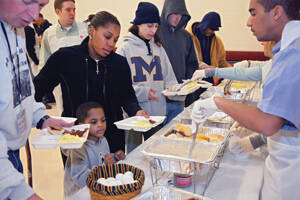The U.S. Census Bureau reported on Sept. 13 the highest number of Americans living in poverty in the 52 years it has collected such estimates. More than 2.6 million additional Americans dropped below the poverty line in 2010. Children were particularly hard hit. The Census Bureau found that 22 percent of children were living in poverty last year, up from 20.7 percent the year before. The poverty threshold for a family of four was $22,113 in 2010.
According to the Census report, median household income declined in 2010 while the poverty rate increased, indicating continuing stress on the nation’s working poor and middle class. There were 46.2 million people in poverty in 2010, up from 43.6 million in 2009, the fourth consecutive annual increase. Real median household income in the United States in 2010 was $49,445, a 2.3 percent decline from the 2009 median. The number of people without health insurance in the United States rose by almost one million to 49.9 million. Just under 31 percent of U.S. Hispanics were uninsured in 2010, compared with 20.8 percent of African-Americans, 18.1 percent of Asians and 11.7 percent of non-Hispanic whites.
In a year when unemployment remained persistently above 9 percent and “real” unemployment—the comprehensive count of the unemployed, “discouraged workers” and part-time workers who would prefer to be full-time—remained almost double that level, the nation’s official poverty rate rose to 15.1 percent. That is up nearly a full percent from 2009’s 14.3 percent and the third consecutive annual increase in the poverty rate. The number of people living in “deep poverty”—that is, with incomes below half of the poverty line—hit a record high of 20.5 million.
Calling the number of uninsured people “intolerably high,” Carol Keehan, D.C., president and chief executive officer of the Catholic Health Association, said the newly released statistics “demonstrate as clearly as ever the need for a strong, sustainable safety net.”
“Policymakers concerned for human dignity and the common good should keep our nation’s vulnerable persons in mind as they deliberate about how best to reduce debt and develop a sensible budget framework,” she said in a statement on Sept. 13. “Such steps should be taken without harming vulnerable people or imperiling the ability of health care providers to deliver the best possible care to all who need it.”
The U.S. South appears to have been hit the hardest in the last year. The South showed “significant increases in both the poverty rate and the number in poverty—16.9 percent and 19.1 million in 2010—up from 15.7 percent and 17.6 million in 2009.” The Census Bureau reports that since 2007 real median household income has declined 6.4 percent. It is now 7.1 percent below the median income peak in 1999.
According to the Center for Budget and Policy Priorities, the “grim” poverty figures probably would have been worse were it not for government interventions like the extension of unemployment insurance in 2010. That measure alone kept 3.2 million more Americans from falling below the poverty line, said Robert Greenstein, president of the center.
“All of that raises the stakes,” Greenstein said in a statement released on Sept. 13, “for the decisions that President Obama and Congress will make in coming months about whether to extend initiatives that were designed to address hardship during the recession, as well as whether to abide by a principle that the Bowles-Simpson commission report established that deficit-reduction plans should not increase poverty and thus should shield basic low-income assistance programs.”








